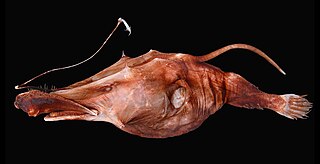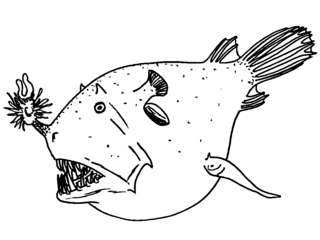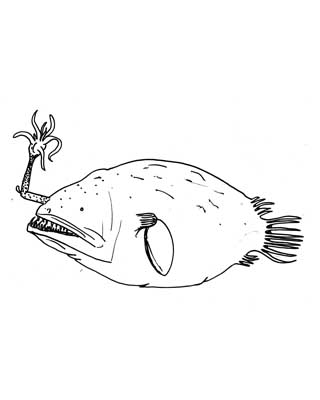
Leftvents are a family, the Linophrynidae, of marine ray-finned fishes which is classified within the suborder Ceratioidei, the deep sea anglerfishes. These fishes are found in the Atlantic, Indian and Pacific Oceans.

The footballfish form a family, Himantolophidae, of globose, deep-sea anglerfishes found in tropical and subtropical waters of the Atlantic, Indian, and Pacific Ocean. The family contains 23 species, all of which are classified in a single genus, Himantolophus.

Fanfins or hairy anglerfish are a family, Caulophrynidae, of marine ray-finned fishes within the order Lophiiformes, the anglerfishes. The fishes in this family are found almost around the world in the deeper, aphotic waters of the oceans.

Double anglers, the family Diceratiidae, is a small and little known family of rarely encountered marine ray-finned fishes belonging to the order Lophiiformes, the anglerfishes. The two genera and seven species of this family are found in the deeper waters of the tropical and subtropical Atlantic, Indian and Pacific Oceans. They are distinguished from other deep sea anglerfishes by the possession of a second bioluminescent cephalic spine. The fishes in this family were known only from metamorphosed females and the males were not described until 1983.

Oneirodidae, the dreamers are a family of marine ray-finned fishes belonging to the order Lophiiformes, the anglerfishes. These fishes are deepwater fishes found in the Atlantic, Indian and Pacific Oceans, and it is the most diverse family of fishes in the bathypelagic zone.
Thaumatichthyidae, the wolftrap anglers, is a small family of marine ray-finned fishes, also called the wolftrap seadevils, classified within the suborder Ceratioidei, the deep-sea anglerfishes. They have distinctive upper jaws with movable premaxillaries that can be lowered to form a cage-like trap around the much shorter lower jaw.
Bertella is a monospecific genus of marine ray-finned fish belonging to the family Oneirodidae, the dreamers, a family of deep sea anglerfishes. The only species in the genus is Bertella idiomorpha and this can be distinguished from other members of the family by the structure of its hyomandibular bone.

Gigantactis is a genus of marine ray-finned fish belonging to the family Gigantactinidae, the whipnose anglers. The fishes in this genus have a circumglobal distribution in the deep waters of the tropical and temperate zones of the Atlantic, Indian and Pacific Oceans.

Lasiognathus, the wolftrap anglerfish, is a genus of deep-sea anglerfish in the family Thaumatichthyidae, with six species known from the Atlantic and Pacific Oceans.

Diceratias is a genus of deep sea marine ray-finned fish belonging to the family Diceratiidae, the double anglers. These fishes are found in the Eastern Atlantic and Indo-Pacific regions.

Borophryne apogon, the netdevil, or greedy seadevil, is a species of leftvent anglerfish known today from the waters of the eastern Pacific Ocean off the Central American coast. It is found at depths down to around 1,750 m (5,700 ft). This species grows to a length of 8.3 centimetres (3.3 in) TL. A fossil specimen of this species has been found in the Los Angeles Basin dating back to the Late Miocene, some eight million years ago.

Chaenophryne is a genus of marine ray-finned fish belonging to the family Oneirodidae, the dreamers, a family of deep-sea anglerfishes. These predatory, deep-sea fishes are found in the tropical and subtropical oceans around the world. Like other deep-sea anglerfishes, they are sexually dimorphic, with the matamorphosed females dwarfing the metamorphosed males. The males are not sexual parasites.
Ctenochirichthys is a monospecific genus of marine ray-finned fish belonging to the family Oneirodidae, the dreamers, a family of deep sea anglerfishes. The only species in the genus is Ctenochirichthys longimanus is known only from two locations, on in the Atlantic Ocean and the other in the Western Pacific Ocean.
Dolopichthys is a genus of marine ray-finned fish belonging to the family Oneirodidae, the dreamers, a family of deep sea anglerfishes. These predatory, deep-sea fishes are found in the tropical and subtropical oceans around the world.

The plainchin dreamarm is a species of marine ray-finned fish belonging to the family Oneirodidae, the dreamers, a family of deep sea anglerfishes. It is the only species in the monospecific genus Leptacanthichthys. This species occurs in the North Atlantic and North Pacific Oceans at depths down to 2,000 m (6,600 ft).
Microlophichthys is a genus of marine ray-finned fish belonging to the family Oneirodidae, the dreamers, a family of deep sea anglerfishes. The species in this genus are found in the tropical and subtropical parts of the Atlantic, Indian and Pacific Oceans.

Oneirodes is a genus of is a genus of marine ray-finned fish belonging to the family Oneirodidae, the dreamers, a family of deep sea anglerfishes. These predatory, deep-sea fishes are found around the world. This is the type genus, and the most speciose genus, of the family Oneirodidae. They are sexually dimorphic but, like most taxa within their family, the small males are free living and are not sexual parasites on the larger females. Only the females are used to identify the species in this genus as no species specific charaxcters have been found for males.

Chaenophryne draco, the smooth dreamer, or smooth-headed dreamer, is a species of marine ray-finned fish belonging to the family Oneirodidae, the dreamers, a family of deep-sea anglerfishes. This predatory, deep-sea fish is found in the tropical and subtropical oceans around the world. Like other deep-sea anglerfishes, it is sexually dimorphic, with the matamorphosed females dwarfing the metamorphosed males. The males are not sexual parasites.
Gigantactis elsmani, Elsman's whipnose, is a species of marine ray-finned fish belonging to the family Gigantactinidae, the whipnose anglers. This species is found in the deeper waters of the Atlantic and Pacific Oceans.
Gigantactis vanhoeffeni is a species of marine ray-finned fish belonging to the family Gigantactinidae, the whipnose anglers. This species has a circumglobal distribution in the deeper waters of the Atlantic, Indian and Pacific Oceans.












